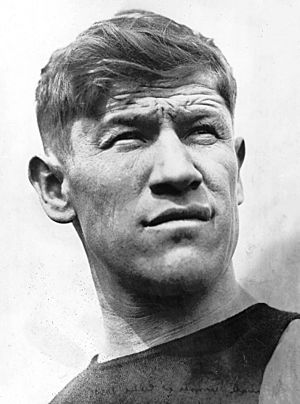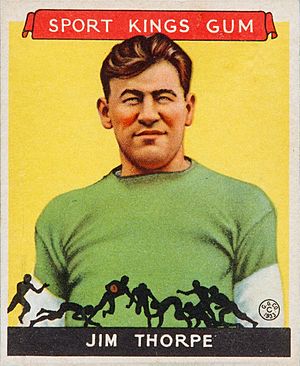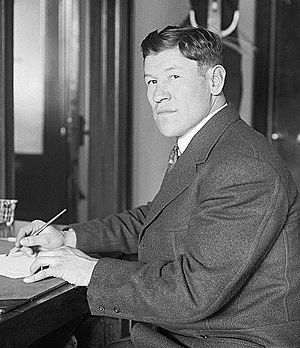Jim Thorpe facts for kids
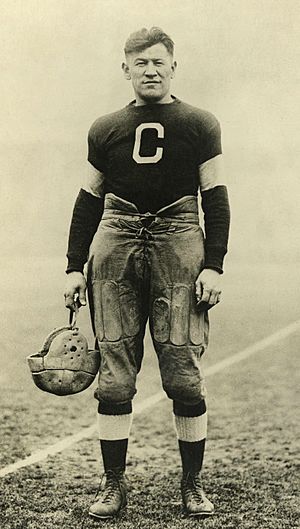
Thorpe with the Canton Bulldogs, c. 1915 – c. 1920
|
|||
| No. 2, 21, 3 | |||
|---|---|---|---|
| Position: | Running back | ||
| Personal information | |||
| Born: | May 22 or 28, 1887 Near Prague, Indian Territory (in modern Oklahoma, U.S.) |
||
| Died: | March 28, 1953 (aged 65) Lomita, California, U.S. |
||
| Height: | 6 ft 1 in (1.85 m) | ||
| Weight: | 202 lb (92 kg) | ||
| Career information | |||
| College: | Carlisle (1907–1908, 1911–1912) | ||
| Career history | |||
| As player: | |||
|
|||
| As coach: | |||
|
|||
| Career highlights and awards | |||
Baseball career |
|||
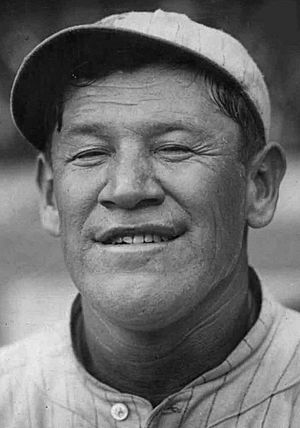
Thorpe as a member of the New York Giants
|
|||
| Outfielder | |||
|
|||
| debut | |||
| April 14, 1913, for the New York Giants | |||
| Last appearance | |||
| September 25, 1919, for the Boston Braves | |||
| MLB statistics | |||
| Batting average | .252 | ||
| Home runs | 7 | ||
| Runs batted in | 82 | ||
| Hits | 176 | ||
| Teams | |||
|
|||
| Career NFL statistics | |||
|
|||
| Head coaching record | |||
| Career: | 14–25–2 | ||
| Player stats at PFR | |||
|
Pro Football Hall of Fame
|
|||
|
College Football Hall of Fame
|
|||
| Olympic medal record | ||
|---|---|---|
| Men's athletics | ||
| Representing the |
||
| Gold | 1912 Stockholm | Decathlon |
| Gold | 1912 Stockholm | Pentathlon |
James Francis Thorpe (May 22 or 28, 1887 – March 28, 1953) was an American athlete and Olympic gold medalist. He is widely regarded as one of the greatest athletes in history. Thorpe won two Olympic gold medals in the 1912 Summer Olympics (one in classic pentathlon and the other in decathlon). He also played football (collegiate and professional), professional baseball, and basketball.
He lost his Olympic titles after it was found he had been paid for playing two seasons of semi-professional baseball before competing in the Olympics, thus violating the contemporary amateurism rules. In 1983, 30 years after his death, the International Olympic Committee (IOC) restored his Olympic medals with replicas, after ruling that the decision to strip him of his medals fell outside of the required 30 days.
Thorpe has received numerous accolades for his athletic accomplishments. The Associated Press ranked him as the "greatest athlete" from the first 50 years of the 20th century. Thorpe was portrayed by Burt Lancaster in the 1951 film Jim Thorpe – All-American.
Contents
Early life
Information about Thorpe's birth, name and ethnic background varies widely. He is generally considered to have been born on May 22, 1887, near the town of Prague, Oklahoma. Thorpe's parents were both of mixed-race ancestry. His father, Hiram Thorpe, had an Irish father and a Sac and Fox Indian mother. His mother, Charlotte Vieux, had a French father and a Potawatomi mother, a descendant of Chief Louis Vieux.
Thorpe attended the Sac and Fox Indian Agency school in Stroud, with his twin brother, Charlie. Charlie helped him through school until he died of pneumonia when they were nine years old. Thorpe ran away from school several times. His father sent him to the Haskell Institute, an Indian boarding school in Lawrence, Kansas, so that he would not run away again.
When Thorpe's mother died of childbirth complications two years later, the youth became depressed. After several arguments with his father, he left home to work on a horse ranch.
In 1904, the sixteen-year-old Thorpe returned to his father and decided to attend Carlisle Indian Industrial School in Carlisle, Pennsylvania. There his athletic ability was recognized and he was coached by Glenn Scobey "Pop" Warner, one of the most influential coaches of early American football history. Later that year the youth was orphaned after his father Hiram Thorpe died from gangrene poisoning, after being wounded in a hunting accident. The young Thorpe again dropped out of school. He resumed farm work for a few years before returning to Carlisle School.
Football superstar
Jim Thorpe became a football superstar at Carlisle. He played halfback and was known for his incredible speed, agility, and strength. He could run, pass, kick, and tackle with exceptional skill.
One of Jim's most memorable football achievements was in 1911 when he led Carlisle to a stunning 18-15 victory over Harvard University, one of the top college football teams in the country. Jim scored all of Carlisle's points in that game, showcasing his remarkable talent. In 1912, he led Carlisle to an undefeated season, scoring 198 points.
Olympic glory
In 1912, Jim Thorpe represented the United States at the Olympic Games in Stockholm, Sweden. He competed in two events: the pentathlon and the decathlon.
- Pentathlon: The pentathlon consisted of five events: running, jumping, wrestling, discus throw, and javelin throw. Jim won four of the five events, securing the gold medal.
- Decathlon: The decathlon was an even more challenging event, consisting of ten events: 100-meter run, long jump, shot put, high jump, 400-meter run, 110-meter hurdles, discus throw, pole vault, javelin throw, and 1500-meter run. Jim won the decathlon with a score of 8,413 points, setting a new world record.
Jim's Olympic victories made him an international sensation. He was hailed as the "world's greatest athlete," and King Gustav V of Sweden reportedly said to him, "Sir, you are the greatest athlete in the world."
Professional sports career
After his Olympic success in 1912, Thorpe added a victory in the All-Around Championship of the Amateur Athletic Union. In 1913, he played for the Pine Village Pros in Indiana. Later in 1913, Thorpe signed with the New York Giants, and he played six seasons in Major League Baseball between 1913 and 1919. Thorpe joined the Canton Bulldogs American football team in 1915, helping them win three professional championships. He later played for six teams in the National Football League (NFL). He played as part of several all-American Indian teams throughout his career, and barnstormed as a professional basketball player with a team composed entirely of American Indians.
From 1920 to 1921, Thorpe was nominally the first president of the American Professional Football Association, which became the NFL in 1922. He played professional sports until age 41, the end of his sports career coinciding with the start of the Great Depression.
Controversy and loss of medals
Tragically, Jim Thorpe's Olympic glory was short-lived. In 1913, it was revealed that he had played semi-professional baseball for a small amount of money before the Olympics. According to the Olympic rules at the time, this made him a professional athlete, which meant he was not eligible to compete in the Olympics.
The International Olympic Committee (IOC) stripped Jim of his Olympic medals and removed his name from the record books. This decision was highly controversial, as many people believed that the rules were unfair and that Jim had been unfairly targeted.
Restoration of Olympic medals
In 1982, the IOC posthumously restored Jim Thorpe's Olympic medals. His name was also reinstated in the Olympic record books. This decision was a victory for those who had long argued that Jim had been unfairly treated.
Later life and death
After the end of his career, Thorpe struggled to earn a living, working several odd jobs, among others as an extra for several movies, usually playing an American Indian chief in Westerns.
Apart from his career in films, he worked as a construction worker, a doorman/bouncer, a security guard, and a ditchdigger. He briefly joined the United States Merchant Marine in 1945, during World War II. Thorpe ran out of money sometime in the early 1950s. He lived his last years in failing health and poverty.
When hospitalized for lip cancer in 1950, Thorpe was admitted as a charity case. At a press conference announcing the procedure, his wife, Patricia, wept and pleaded for help, saying, "We're broke ... Jim has nothing but his name and his memories. He has spent money on his own people and has given it away. He has often been exploited."
In early 1953, Thorpe went into heart failure for the third time. He died on March 28 at the age of 65.
Marriage and family
Thorpe married three times and had a total of eight children. In 1913, Thorpe married Iva M. Miller, whom he had met at Carlisle. In 1917, Iva and Thorpe bought a house now known as the Jim Thorpe House in Yale, Oklahoma, and lived there until 1923. They had four children: James F., Gale, Charlotte, and Frances Thorpe. Miller filed for divorce from Thorpe in 1925, claiming desertion.
In 1926, Thorpe married Freeda Verona Kirkpatrick (September 19, 1905 – March 2, 2007). She was working for the manager of the baseball team for which he was playing at the time. They had four sons: Phillip, William, Richard, and John Thorpe. Kirkpatrick divorced Thorpe in 1941, after they had been married for 15 years.
Lastly, Thorpe married Patricia Gladys Askew on June 2, 1945. She was with him when he died.
Interesting facts about Jim Thorpe
- Thorpe was the first Native American to win a gold medal for the United States in the Olympics.
- His Native American name was Wa-Tho-Huk, which means "Bright Path."
- Jim was a skilled dancer and won several dance competitions.
- He was also a talented singer and played several musical instruments.
- Jim was known for his sense of humor and his ability to make people laugh.
- Thorpe was the last man to compete in both the Olympics (in a non-baseball sport) and Major League Baseball before Eddy Alvarez did the same in 2020.
- President Richard Nixon, as authorized by U.S. Senate Joint Resolution 73, proclaimed Monday, April 16, 1973, as "Jim Thorpe Day" to promote nationwide recognition of Thorpe's life.
- In 1986, the Jim Thorpe Association established an award with Thorpe's name. The Jim Thorpe Award is given annually to the best defensive back in college football.
- The annual Thorpe Cup athletics meeting is named in his honor.
Legacy
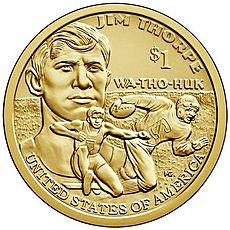
Jim Thorpe's story is one of incredible athletic talent, triumph, and tragedy. He overcame challenges and achieved greatness in multiple sports. He accomplished his athletic feats despite the severe racial inequality of the United States. It has often been suggested that his Olympic medals were stripped by the athletic officials because of his ethnicity. While it is difficult to prove this, the public comment at the time largely reflected this view. At the time Thorpe won his gold medals, not all Native Americans were recognized as U.S. citizens (the U.S. government had frequently demanded that they make concessions to adopt European-American ways to receive such recognition). Citizenship was not granted to all American Indians until 1924.
The Jim Thorpe Area Running Festival is a series of races started in 2019 in Jim Thorpe, Pennsylvania. It includes a marathon, a 26.2 mile footrace that features a steady elevation drop from start to finish.
The United States Postal Service issued a 32¢ stamp on February 3, 1998, as part of the Celebrate the Century stamp sheet series.
Jim Thorpe, Pennsylvania
After Thorpe's funeral was held in Shawnee, Oklahoma, his body lay in state at Fairview Cemetery. Residents had paid to have it returned to Shawnee by train from California. The people began a fund-raising effort to erect a memorial for Thorpe at the town's athletic park. Local officials had asked state legislators for funding, but a bill that included $25,000 for their proposal was vetoed by Governor Johnston Murray.
Meanwhile, Thorpe's third wife took Thorpe's body and had it shipped to Pennsylvania when she heard that the small Pennsylvania towns of Mauch Chunk and East Mauch Chunk were seeking to attract business. The towns "bought" Thorpe's remains, erected a monument to him at the grave, merged, and renamed the newly united town in his honor as Jim Thorpe, Pennsylvania. Thorpe had never been there. The monument site contains his tomb, two statues of him in athletic poses, and historical markers recounting his life story.
In June 2010, Jack Thorpe filed a federal lawsuit against the borough of Jim Thorpe, seeking to have his father's remains returned to his homeland and re-interred near other family members in Oklahoma. However, Jack Thorpe died at 73 on February 22, 2011. On October 5, 2015, the United States Supreme Court refused to hear the matter, effectively bringing the legal process to an end.
Achievements
- Olympic gold medals in the pentathlon and decathlon (1912)
- College football All-American (1911, 1912)
- Professional baseball player (1913-1919)
- Professional football player (1915-1928)
- Pro Football Hall of Fame inductee (1963)
- National Native American Hall of Fame inductee (2018)
Key Dates
- May 22, 1887: Born near Prague, Oklahoma
- 1904: Enrolls at Carlisle Indian Industrial School
- 1911: Leads Carlisle to victory over Harvard
- 1912: Wins Olympic gold medals in pentathlon and decathlon
- 1913: Stripped of Olympic medals
- 1913-1919: Plays professional baseball
- 1915-1928: Plays professional football
- March 28, 1953: Dies at age 65
- 1982: Olympic medals posthumously restored
Images for kids
-
Thorpe shaking hands with Moses Friedman while Glenn "Pop" Warner (left), Lewis Tewanima (center), and a crowd look on
-
Thorpe in Carlisle Indian Industrial School uniform, c. 1909
See also
 In Spanish: Jim Thorpe para niños
In Spanish: Jim Thorpe para niños


